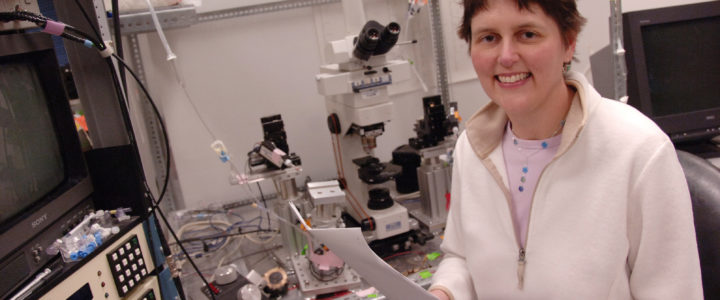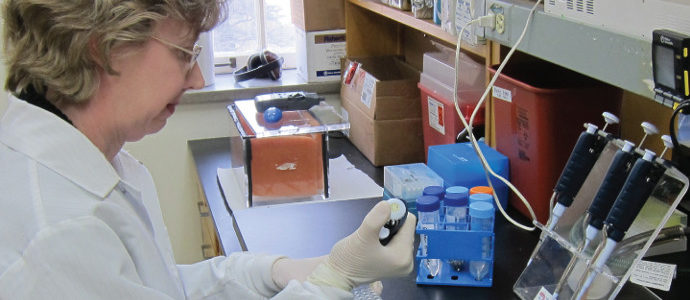With $384,345 in grants from FRAXA Research Foundation, Dr. MariVi Tejada from the University of Houston focused on a particularly promising point of intervention in pathways of brain receptors, and tested several potential therapeutic compounds in an attempt to rescue function in the mouse model of Fragile X.
Read more
Evaluation of CamKII Dependent Regulation of mGluR5-Homer Scaffolds as a Potential Therapeutic for Fragile X Syndrome
With a $90,000 grant from FRAXA Research Foundation, Dr. Kimberly Huber and Dr. Weirui Guo at the University of Texas at Southwestern investigated the roles of Homer and CaMKII in Fragile X syndrome.
Read moreClinical Trials FAQ ← Frequently Asked Questions
Question: How Do Families Decide Which Trial is Best for Them? Answer: Each of the trials has different requirements for joining, so many – if not most – people will only be eligible for one trial after screening. The best way to approach this is to call the clinic contact closest to your area and discuss this with him/her. Age, weight, current medications, behavior, and IQ are all factors.
Read moreDarren’s Smile
Darren’s Smile – This is a very difficult post to write because it is about a son, Darren, who has passed away. Darren’s dad has written a memoir – a beautiful tribute to his son. Darren had Fragile X syndrome. He lived a rich life and was very much loved. Sadly he died because of a choking incident at the group home where he lived. There’s not much written about the risk of choking for people who have Fragile X, but I do wonder if it is a particular risk that we should remember.
Read moreFRAXA Progress and Future Plans
It’s official: Fragile X is now the hottest research topic in all of neuroscience! Just last month, massive publicity attended the publication of Fragile X clinical trial results and major papers by FRAXA’s outstanding translational researchers. Even as news of the first round of Fragile X clinical trials is emerging, Phase III trials (which can lead to actual marketing of medications) are under way and slated to finish around the end of the year. This is exciting, and it is just the tip of the iceberg.
Read more
NPR, “Progress Made On Drug For Autism Symptoms”
An experimental drug that helps people who have Fragile X syndrome is raising hopes of a treatment for autism. The drug, called arbaclofen, made people with Fragile X syndrome less likely to avoid social interactions, according to a newly published study. Researchers suspect it might do the same for people with autism.
Read more
A Developmental Switch Exists in the Effects of FMRP
With a $90,00 grant from FRAXA Research Foundation for 2010-2011, Dr. Kimberly Huber and her team at the University of Texas at Southwestern found that there is a developmental switch of postsynaptic FMRP on synaptic function. This switch is controlled by MEF2 transcriptional activity. Proper synapse maturation and elimination is crucial for the establishment of appropriate neural circuits that underlie sensory processing and cognition. Neuron of Fragile X patients as well as in the mouse model of Fragile X, Fmr1 KO mice, display more dendritic spines, the point of contact for excitatory synapses, as well as long and thin filopodia resembling immature spines. This suggests Fragile X mental retardation protein (FMRP) has a role in promoting synapse maturation and elimination.
Read more
Ab-Mediated Translation in Fragile X Syndrome
With a $120,000 grant from FRAXA Research Foundation during 2011-2012, Dr. Cara Westmark at the University of Wisconsin explored the role of AbPP as a potential treatment option for fragile X. AbPP produces b-amyloid which is over-expressed in Alzheimer’s disease (AD) and Down syndrome.
Read more
Synaptic Actin Signaling Pathways in Fragile X
With a $163,356 grant from FRAXA Research Foundation in 2010-12, Dr. Scott Soderling and Dr. Hwan Kim at Duke University bred the standard mouse model of Fragile X syndrome to their lines of mice that express reduced levels of several key proteins that modulate synaptic actin. These compound mutant mice were compared to FXS mice to determine if genetically impairing pathways to the actin cytoskeleton can rescue deficits in the FXS mice.
Read moreWhat Works, and What Doesn’t
At the start, it’s always hard to know what methods will work best for something as complex as the development of disease-modifying treatments for Fragile X. But, we’ve always tried to let the science lead us down the right path. At this point, the results are unequivocal, and they have shaped how we are looking for the Next Great Thing in Fragile X treatments.
Read more
Genetic and Pharmacologic Manipulation of PI3K Activity in FXS: Assessing Potential Therapeutic Value
With a $90,000 grant from the FRAXA Research Foundation, Dr. Gary Bassell and his team at Emory University explored the PI3K/mTOR signaling complex in FXS via genetic and pharmacologic rescue approaches, to reduce the enzymatic function of specific components of this complex pathway in an FXS mouse model.
Read more
Reward Function in Fragile X Syndrome
With a $82,500 grant from FRAXA Research Foundation in 2011-2012, Dr. Christopher Cowan and Dr. Laura Smith explored the role of specific signaling pathways in drug-related behavioral deficits, including determining the role, if any, of known impairments in the Fragile X brain.
Read more
A Metabolomic Drug Efficacy Index to Test Treatments in the Fragile X Mouse
Dr. Davidovic has been examining changes in metabolism in various brain regions that are affected in Fragile X patients. She has defined a brain-specific metabolic signature of FXS and is testing treatment strategies to restore normal levels of these metabolites.
Read more
Inherited Channelopathies in Cortical Circuits of Fmr1 KO Mice
With this two year award of $90,000, Dr. Zhang and Principal Investigator Dr. Andreas Frick at Neurocentre Magendie in France investigated channelopathies using Fragile X mice. Many other proteins are misregulated as a result of the absence of FMRP. It is known that many ion channels, the pores in the cell membrane which allow neurons to conduct electrical impulses, have altered levels in Fragile X. This state is sometime called a “channelopathy” in the pharma world. This group is studying the effect of specific alterations in ion channels, and potential therapeutic effects of drugs which open and close these channels.
Read moreCompound that Inhibits mGluR5 Corrects Signs of Fragile X in Adult Mice
A study finds that a new compound reverses many of the major symptoms associated with Fragile X syndrome (FXS). The paper is published in the April 12 issue of the journal Neuron, describing the exciting observation that the FXS correction can occur in adult mice, after the symptoms of the condition have already been established. Previous research has suggested that inhibition of mGlu5, a subtype of receptor for the excitatory neurotransmitter glutamate, may ameliorate many of the major symptoms of the disease. This study, a collaboration between a group at Roche in Switzerland, led by Dr. Lothar Lindemann, and Dr. Mark Bear’s MIT lab, used an mGlu5 inhibitor called CTEP to examine whether inhibition of mGlu5 could reverse FXS symptoms.
Read moreSpreading Sunshine
When a woman named Doris Buffett decided to embrace us, her warmth spread over us like a blanket, and the impact of her presence was immediate. As mothers and fathers of Fragile X children, we felt encouraged by the light Doris cast our way. We felt honored that the Sunshine Lady and her Foundation directors chose to invest in our children and our future. We were reinvigorated because of her generous financial support and her profound vision. Doris called FRAXA “The Gold Standard” in grass roots charities and donated more than $3 million to FRAXA in challenge grants. With our deepest gratitude, we are once again thanking Doris Buffett’s Sunshine Lady Foundation for her latest gift.
Read moreFRAXA Announces 2012 Fragile X Research Awards
In 2012, Fragile X Research was awarded $1,132,923 in new program grants, postdoctoral fellowships, and renewals. We are funding over $846,000 in new projects; renewals totalling $285,678 and will increase as additional projects reach their one year mark. View report here.
Read more
In Vitro Coherent Network Activity
With a $90,000 grant from FRAXA Research Foundation from 2011-2012, Dr. Juan Bacigalupo at the University of Chile studied the abnormal network dynamics of the brain in Fragile X mice to provide information for future therapeutic drug screening.
Read more
Role of JNK in FMRP Regulated Translation in Fragile X Syndrome
With a $90,000 grant from FRAXA Research Foundation over 2 years, Dr. Michael Wilhelm and his team at the University of Wisconsin studied a protein known as JNK, which is observed to be abnormally regulated in Fragile X. Like FMRP, it is involved in regulating dendritic protein synthesis, and so it may be a target for drug therapy in Fragile X.
Read more
Serotonergic Rescue of Synaptic Plasticity in FMR1 Knockout Mice
With $306,000 in grants from FRAXA Research Foundation, Dr. Julius Zhu from the University of Virginia examined the effects of several drugs such as Buspar and Abilify which manipulate specific serotonin receptors and the effect that has on synaptic plasticity (LTP and LTD).
Read more
Efficient Screening for Pharmaceutical Amelioration of FXS Behavioral Deficits in Drosophila
With a $112,250 grant from FRAXA Research Foundation over 3 years, Dr. Efthimios Skoulakis and his team from the Institute of Cellular and Developmental Biology conducted the first FRAXA project in Greece, where they developed a speedy new test for learning problems in fruit flies, which allowed them to test a number of drugs that are potential Fragile X treatments.
Read more160 scientists and dozens of parents attended the FRAXA Investigators Meeting
FRAXA Investigators Meeting was held from September 18-21, 2011 in Southbridge, MA. The goal: to find and implement treatments for Fragile X. Congratulations to Drs. Mark Bear, Emily Osterweil, and Elizabeth Berry-Kravis who won FRAXA research awards. The meeting report is here.
Read more
Channelopathies: Altered Ion Channels in Fragile X Syndrome
With a $95,000 grant from FRAXA Research Foundation from 2010-2011, Dr. Daniel Johnston and Dr. Darrin Brager at the University of Texas at Austin investigated alterations in ion channels in Fragile X syndrome. They explored potential therapeutic effects of drugs which open and close these channels. Results published.
Read more
Role of Excessive Protein Synthesis in the Ontogeny of FXS
With a $90,000 grant from FRAXA Research Foundation in 2010-2011, Dr. Mark Bear and Dr. Miquel Bosch tested the simple hypothesis that the excessive rate of protein synthesis is not a consequence but the primary cause of the structural alterations occurring in Fragile X syndrome.
Read more
Altered Dendritic Synthesis of Postsynaptic Scaffold Protein Shank1 in Fragile X Syndrome
With a $106,800 grant from FRAXA Research Foundation over 2 years, Drs. Stephan Kindler and Hans-Jurgen Kreieinkamp studied a protein, Shank1, which is overabundant in Fragile X syndrome.
Read more
